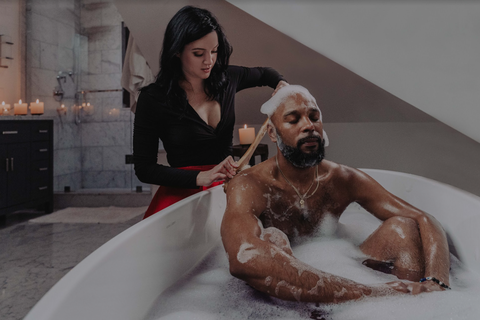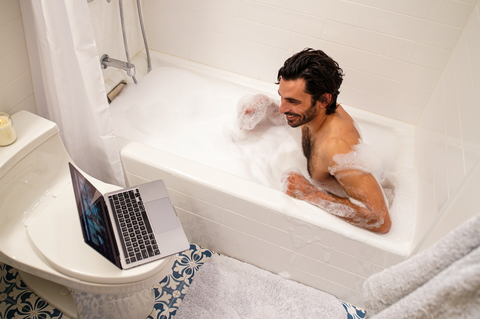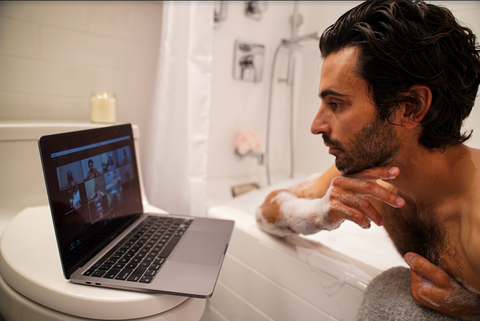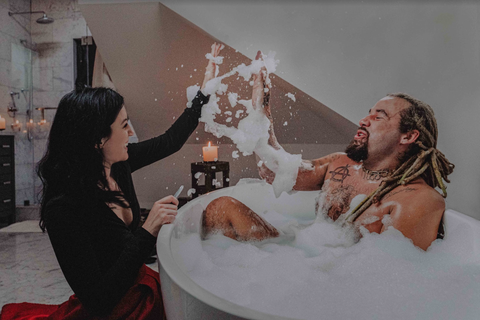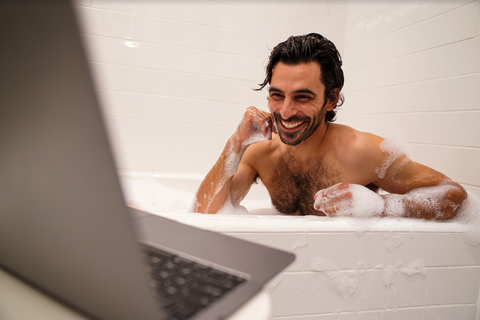Typically, I don’t spend my Tuesday nights with a group of naked men. But there I was one late-pandemic evening, chest-deep in steaming, bubbly water, attempting to click on a “join meeting” link without plunging my MacBook into the tub. In just a few moments, I’d be wading deep into the male psyche with nine members of a new kind of discussion forum for guys called Men Who Take Baths.
I first came across the organization on Instagram, where I scrolled through a curated feed of soapy, smiling dudes reclined in porcelain and thought to myself: now, this is something I have to explore. What those glossy images captured was an extensive one-on-one interview series started by Men Who Take Bath’s founder, Nicolle Hodges, back in 2017.
The Canadian journalist, author, and self-described “sexual freedom philosopher” had been talking with a male friend who shared that he secretly loved baths but wouldn’t tell others because it wasn’t “manly.” Soon after, the idea to interview guys naked in the tub came to her with such force that it felt “like a memory of something I had already done.”
Hodges began hand-delivering paper scrolls to exemplary men in her life that asked them to “accept the mission” within 24 hours. Not only did none of them say no, when the time came to strip down, they also leaned in.
The men spoke about feminism and equality while also opening up about challenging topics: friends dying by suicide; heartbreak; calling off a wedding; cheating on a partner; losing a baby; experiencing racism; fighting in the military; struggling with body dysmorphia; the fear of coming out.
Those powerful conversations were posted to her blog but soon led to live events. (Yes, guys took nude baths in front of sold-out audiences). The pandemic pumped the brakes on Hodge’s expansion efforts, however, what she realized throughout the interviews was that while men yearn for community, they generally suck at it. So, she recruited Flynn Skidmore, a 30-year male psychotherapist from Brooklyn, to help her figure out how to get the men’s group version of Men Who Take Baths off the ground. (Men’s groups are confidential spaces where they can speak candidly about their lives).
It would be fair to say that I know a thing or two about guys getting together to share their troubles. I’ve sat with ManKind Project men’s groups, delved (skeptically) into male spaces on Clubhouse, and even founded a romance book club for bros.
So, when Hodges and I agreed that I would join the guys for one of their 90-minute sessions, I was excited by the notion of an aquatic exploration of modern masculinity. But I couldn’t help but wonder: could this simple act of self-care be that effective at washing away male defenses? Would guys open up more than usual because of the bath?
When the Zoom started, the men’s faces began to pop onto the screen. I took note of the wide variety of bathroom tiling and chuckled when I heard one of the guys say to another, “You’re the kind of guy that would soak his feet in Jim Beam.”
Before the session, Skidmore had added me to their group on WhatsApp to get to know the other men. I had used the opportunity to ask some essential logistical questions: Aren’t we going to be cold, pruney, and miserable after ninety minutes in the tub? Answer: We get out of the bath at the halfway mark. And perhaps more importantly: What is the policy on adult beverages to accompany the soak? Answer: totally fine, maybe even encouraged. So, throughout much of the session, I had a tumbler of bourbon in hand.
Once they realized that I’d joined, the group offered me a cavalcade of hellos. Then, Skidmore opened the session with a short meditation. While telling us to imagine a “5% smile” from our chest to our lips, the bemuscled and bountifully tattooed facilitator combined the throaty intonation of a surfer with the vocal cadence of a master of zen.
We moved on to the main event and discussed who would begin the sharing part of the session. The guys had already dished on all kinds of issues in the WhatsApp group: enforcing boundaries; lulls in sexual intimacy; fear of breaking commitments; the illusion of control. However, it had been Gus, a 35-year-old professor living in San Jose, that presented the most pressing problem: He was questioning his marriage. We decided Gus would share first.
Given the premise of the organization, I was a bit surprised to find that, while most of the guys were naked and submerged, several of the men, like Nate, were bath “adjacent” because they didn’t have access to a tub. The 35-year-old tech worker from Arizona sat bare-chested in an office chair with a gamer headset over his ears and a concoction of oil, flowers, hot water, and salt soaking his feet.
Gus happened to be returning solo from a road trip to San Diego, but he, too, kept the bathing spirit alive by joining us shirtless from the car. “I just keep feeling like everything is wrong, and it’s all my fault,” he said.
As the other men took turns offering empathetic shares and queries, Gus elaborated on his struggles, noting that he’d realized several months ago that he has severe issues with attachment. The men offered encouraging noises of affirmation along with psychologizing language like holding space and attachment style.
“My therapist keeps saying I should self-soothe,” Gus said. “I don’t even know what that means.” After nearly 10 minutes of patient, supportive dialogue, Kev, a 31-year-old video producer from Toronto, seized the moment for levity. “It means masturbate,” he quipped buoyantly, sending the entire group into a collective guffaw.
Watching the men enjoy each other’s company made it clear that they had grown close during their six weeks of shared splash time. But that still didn’t address my question as to how the bath specifically helped them navigate tricky emotional terrain.
Before the session, I had come across a 2018 German study suggesting that taking regular hot baths could be as effective as exercise at combating depression and boosting mood. However, when I later connected with Dr. Johannes Naumann, the lead author of the academic article, he was cautious about comparing their study’s participants with a water-bound men’s group.
Dr. Naumann clarified that their work had focused on raising participants’ body temperature through extended exposure to extremely hot baths. But he did point to the healing power of warm water and the Finnish tradition of social sauna-ing to explain why the tub setting might create a sense of emotional ease.
“If you take some friends and get a nice bath…everyone will say, ‘Wow, I’m so relaxed,” Dr. Naumann said. “You don’t need a trial or study to prove that.”
There were indeed moments during the first part of the session when the bubbly warmth seemed to wrap around me like a reassuring hug. But I was surprisingly relieved when the time came to get out of the tub because, overall, I found the process to be a logistical faff.
In anticipation of the extended session, I had made a rookie mistake, filling my tub with scalding water that left me cursing and breathless. “Been there many times, no rush, we don’t want any burn wounds,” Skidmore had responded when I messaged the group that I would be a few minutes late.
Also, the bathroom tiling had made for a horrendous acoustic environment. A ghost-like echo had haunted our conversation because none of us bothered to dry our hands and put ourselves on mute.
But the worst part was that I wasn’t prepared to sit so long against a hard surface. Each time I tried to find a new, more comfortable position, my heel accidentally struck the spring-loaded drain, eventually leaving me cold and shivering in only a few inches of water and foam.
When I raised these issues in separate conversations with Skidmore and Hodges after the session, they both laughed. Skidmore has learned to let all of that go. “If I don’t have time to run a bath, I’ll just sit naked in the bathtub,” he said. Hodges is convinced that the mishaps enhance the experience. “The absurdity allows it to be playful,” she said. “This deep work…doesn’t have to be a grind.”
After our 5-minute no-camera break, we returned to the meeting dressed in comfortable clothes. I opted for sweatpants and a T-shirt but was slightly jealous when I noticed that several other guys had donned cozy bathrobes.
As we kicked the conversation back off, Skidmore checked in with Gus. “How are you feeling in your body?” he asked. “Good, thank you guys,” Gus said. “That was really, really helpful.” Then, the group shifted to discussing the not-so-easy-breezy topic of dealing with rage.
Fatim, a 33-year-old educator from Philadelphia, shared that he’s learned to “transform anger into curiosity.” But it wasn’t until I caught up with him after the session that I understood the full context around what he’d said. Much of Fatim’s upbringing was spent in foster homes because his mother, who lives with schizophrenia, couldn’t provide him with adequate care. He’s been in and out of therapy for many years, but he joined Men Who Take Baths because he’d been searching for a venue where guys could “redefine and understand their own masculinity.”
When he dialed into his first Zoom call to meet the other men, he was surprised to find that he was the only person of color. (Hodges’ original interviews featured men from diverse backgrounds, and she says she hopes more men of color will “see a piece of themselves” in the interviews and consider signing up). Fatim attributes the scarcity of Black men to the way society discourages them from being vulnerable: “We’re told that…white people do all the emotional shit,” he told me, “and Black people should be tough.”
Naturally, he would feel more comfortable seeing more faces that look like his. “It just feels better when someone from your culture can reaffirm and confirm the sorts of things that you’ve been experiencing,” he said. “But I feel good knowing that we all support each other, and I do value the objectives and values that are in that group.”
“For all the progress I’ve made writing about my troubles, I’m still highly resistant to actually feeling out loud.”
Back in the session, we were nearing the end. And, except for a few comments and questions here and there, I hadn’t said much. But after listening to these men counsel each other for nearly 90 straight minutes, I wanted, perhaps even needed, their support.
When Skidmore offered one last opening for shares, I told the guys how I’ve struggled to truly connect with and express darker emotions, like sadness, ever since I was a teen. “I have the logical problem-solving capacity to sort through the tangles of my interior life,” I said. “But it’s hard for me to step through the door and just feel it.”
I received a bevy of helpful thoughts; however, Ciarán, a 35-year-old creative producer from Canada with a burnt strawberry beard, offered the response that resonated the most. “When you feel something, you’re being yourself,” he said. “And I think one of the things we’re most scared of is being ourselves.”
As I thought about that, I realized that, for all the progress I’ve made writing about my troubles, I’m still highly resistant to actually feeling out loud. And hopefully, my emotions would flow more easily as I continue to narrow the gap between the external performance of my identity and the authentic version of myself.
We closed off the session with a discussion about the power of tears. And while there were none in this session, as I listened to Tristan, a 30-year-old Canadian health worker, say, “I feel so good after a good cry,” I got the sense that, if the moment called for it, none of these guys would have trouble letting it rip.
By the time we finished the conversation, we’d gone for over two hours, more than 30 minutes over our allotted time. I called Skidmore the next day to regroup. And when I asked how he’d compare Men Who Take Baths to other men’s work organizations, he said, “it’s the cool one because it’s the one that’s informed by cool women.” (Hodges’s team also includes her female head of strategy, Erin Dafos).
I thought back to my first conversation with Hodges when I was curious about Men Who Take Baths. “The basis of the project is to heal the divide,” she said. By that, she meant that, for men to live richer lives, they must reintegrate the parts of themselves—vulnerability, compassion, openness—that society has wrongly said will make them feminine and weak.
That takes a certain kind of hunger for self-examination. And the fact that most of these men show up naked in a bathtub each week certainly helped facilitate a particular type of emotional nudity. But many of them were already in therapy, already equipped with the language of feelings, already scratching at the question, “how can I be the absolute best version of me?”
So, what had made the night magical was not our sudsy surroundings but the fact that these men had come to the session prepared to strip down and dive deep. And you don’t need a tub for that.
Source: Read Full Article
